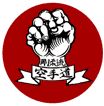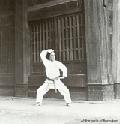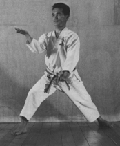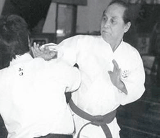Kata History & List
A kata is a pattern of movements which contains a series of logical and practical attacking and blocking techniques. In each kata there are certain set or predetermined movements which the karate-student can practice alone, without a partner. These kata have been created by previous masters after many years of research, training, and actual combat experience.
The true meaning and spirit of karate are embedded in the kata and only by the practice of kata can we come to understand them. For this reason, if we change or simplify the kata either to accomodate the beginner of for tournament purposes, then we also will have lost the true meaning and spirit of karate!
In karate there is no first attack. Every kata begins with a defensive movement, which exemplifies this spirit. Not only is there no first attack, but the best defense is to avoid the fight altogether. That is why it is said that karate is the art of a wise man.
Almost all of the Okinawa Goju Ryu kata were handed down from Higashionna Kanryo Sensei (teacher of Goju Ryu founder Chojun Myagi Sensei). Higashionna Sensei had studied and trained for many years under Ryu Ryuko Sensei in Fukien Province, China. The following kata were handed down by Higashionna Sensei from Ryu Ryuko Sensei: Sanchin, Saifa, Seinchin, Shisochin, Sanseiru, Seipai, Kururunfa, Seisan, and Suparinpei. The original creators of these kata are unknown..
Many of the kata names are Chinese numbers symbolizing certain Buddhist concepts. For example, Suparinpei (the number 108 in Chinese) has a special significance in Buddhism. It is believed that man has 108 evil passions, and so in Buddhist temples on December 31st, at the stroke of midnight, a bell is rung 108 times to drive away those spirits. The number 108 in Suparinpei is calculated from 36x3. The symbolism of the number 36 is given in the explanation of Sanseru which follows. The number 3 symbolizes past, present, and future.
Bunkai is the application of the kata. It is practised with two persons. One of them is the attacker and the other one the defender, which uses the techniques of the kata to defend him/her-self.
Fukyu Kata 普及型
Taikyoku Kata 体極
Taikyoku literally means first course. It means also, according to a translator of the Karate do Kyohan: "... a philosophical term for the macrocosmos, for it's differentiation in heaven and earth (energy and matter): so, it's the chaos of emptiness." Gichin Funakoshi, the founder of the Shotokan Karate do style, created the original Taikyoku katas. The Goju-Ryu versions have been adapted to certain aspects of the Goju style, like Shiko and Sanchin Dachi. They all follow the basic "H"-pattern. The creator is Gogen Yamaguchi.
Gekisai Kata 撃碎
Gekisai literally means to destroy, "Di Ichi (Ni)" means number one (two). This Kata was created by the founder of Okinawa Goju Ryu, Miyagi Chojun Sensei. It consists of basic techniques which facilitate the later learning of difficult ones in the classic Kata starting from Saifa.
The creator is Miyagi Chojun.
Kihon Kata 基本型
Sanchin 三戰
Sanchin means "three battles". It does not refer to actual physical battles, but the internal battle of harnessing body, mind, and spirit through will. It is a classically "hard" Kata, involving continuous muscular tension throughout the body, as well as hard "ibuki" breathing. It is characterized by loud, focused and intense breathing, as well as the sanchin pigeon-toed stance which is characteristic of Goju-Ryu.
The creator is Kanryo Higaonna.
Tensho 転掌
Was created by Miyagi Chojun Sensei. It means flowing hands. It's a combination of the hard dynamic tension with "ibuki" breathing (go) and soft flowing hand movements (ju), while the power comes from the Tandem. This Kata is very characteristic for the Goju-Ryu style and finds it's roots in a Chinese 'soft'-Sanchin version.
The creator is Miyagi Chojun.
Kaishu Kata 開手型
Saifa 碎破
Literally means tear apart and destroy/smash and tear. It is the first classic Kata in the Goju-Ryu repertoire of Kata. Classic in the sense that is was handed down by Ryu Ryuko Sensei to Higaonna Kanryo Sensei. Its origins are most likely to be found in the white crane boxing-style in China.
The creator is Ryu Ko.
Seinchin 制引戰
Probably means silently marching far or to pull depending on the interpretation. It's a very old Chinese Kata, of which the roots probably can be found in the Hsing-I system. This Kata consists, unlike most other Kata, only out of hand techniques. It belongs to the tiger series of the Kata.
The creator is Ryu Ko.
Sanseiru 三十六手
Written in Chinese characters, is the number 36. Symbolically it is calculated from the formula 6x6. The first 6 represents eye, ear, nose, tongue, body, and spirit. The second six symbolizes colour, voice, smell, taste, touch, and justice.
The creator is Ryu Ko.
Seipai 十八手
Similarly, is the number 18. It is calculated from 6x3. The 6 is the same as the second 6 of Sanseiru. The 3 represents good, bad, and peace. This Kata truly exemplifies the true spirit of Okinawa Goju-Ryu: a mixture of soft, round techniques (the ju-principle) with hard ones (the go-principle). Yagi Meitoku often said it is based upon crane techniques which can be seen in the leaning stances, whipping style of striking, and evasive footwork.
The creator is Ryu Ko.
Shisochin 四向戰
Literally means fight in four directions. One reason for this is that this Kata typically includes a combination of techniques executed in four directions. It is of Chinese origin, taught to Kanryo Higaonna by Ryu Ryuku. It is said to be one of Chojun Miyagi's favourite Kata in his later years, and that it was well suited to his body.
The creator is Ryu Ko.
Seisan 十三手
Literally means thirteen hands. It contains 8 defensive and 5 attacking techniques, with which there is a change of direction. Thirteen is a prime number and in China is a number representing good luck and prosperity. Traditional Goju-Ryu falls back upon techniques which involve the grabbing and the controlling of the opponent while a weak spot of the body is hit. This Kata is a perfect example of this principle. It emphasizes close range fighting using short punching and low kicking techniques to break through the defence of the opponent. Seisan is an extremely important Kata in Goju-Ryu and it should be practiced for many hours for it contains a wealth of information and knowledge.
The creator is Ryu Ko.
Kururunfa 久留頓破
Means forever peacefulness, stops tearing. This was handed down from the Chinese master, Ryu Ryuku to Higaonna Kanryo Sensei but the original creator of this Kata is unknown. Kururunfa contains a wide variety of open-hand techniques and especially hand/hip co-ordination techniques. Like Seisan, Kururunfa has soft movements followed by hard movements, however in Kururunfa the difference between hard and soft are much more marked with slow drawn out movements followed by a pause with devastating explosive techniques to follow, then the cycle repeats again.
The creator is Ryu Ko.
Suparinpei 壱百零八手
(Pechurin), One hundred and eight (3x36=108). This Kata has special significance in Buddhism. It is believed that man has 108 evil passions and so in Buddhist temples on December 31st, at the stroke of midnight, a bell is rung 108 times to drive away those spirits. The number 108 is calculated from 3x36. The symbolism of the number 36 is the same as in Sanseiru (eyes, ears, nose, tongue, body and spirit; colour, voice, taste, smell, touch and justice). Suparinpei is Goju-Ryu's longest Kata. It utilises a large number of techniques, including breath control, and it contains the greatest number of applications and depth of meaning. It is said the mastery of Suparinpei is the mastery of the Goju-Ryu system.
The creator is Ryu Ko.
Tokutei Kata 持定 型
Genkaku 玄鶴
Gen means "deep, profound, dark, black, mysterious, obscure" en Kaku means "crane"; Gen-kaku can thus be translated as Mysterious Crane or Black Crane.
The creator is Goshi Yamaguchi.
Chikaku 地鶴
Chi means "ground, earth" and Kaku means "crane" and thus Chi-kaku can be translated as Crane on the ground.
The creator is Goshi Yamaguchi.
Kouryu 天龍
Kou means "yellow" and Ryu means "dragon" and thus Kou-ryu can be translated as Yellow Dragon.
The creator is Goshi Yamaguchi.
Tenryu 黃龍
Ten means "air, heavenly, celestial, god" and Ryu means "dragon"; Ten-ryu can thus be translated as Heavenly Dragon, Divine Dragon or Dragon from the sky.
The creator is Goshi Yamaguchi.














